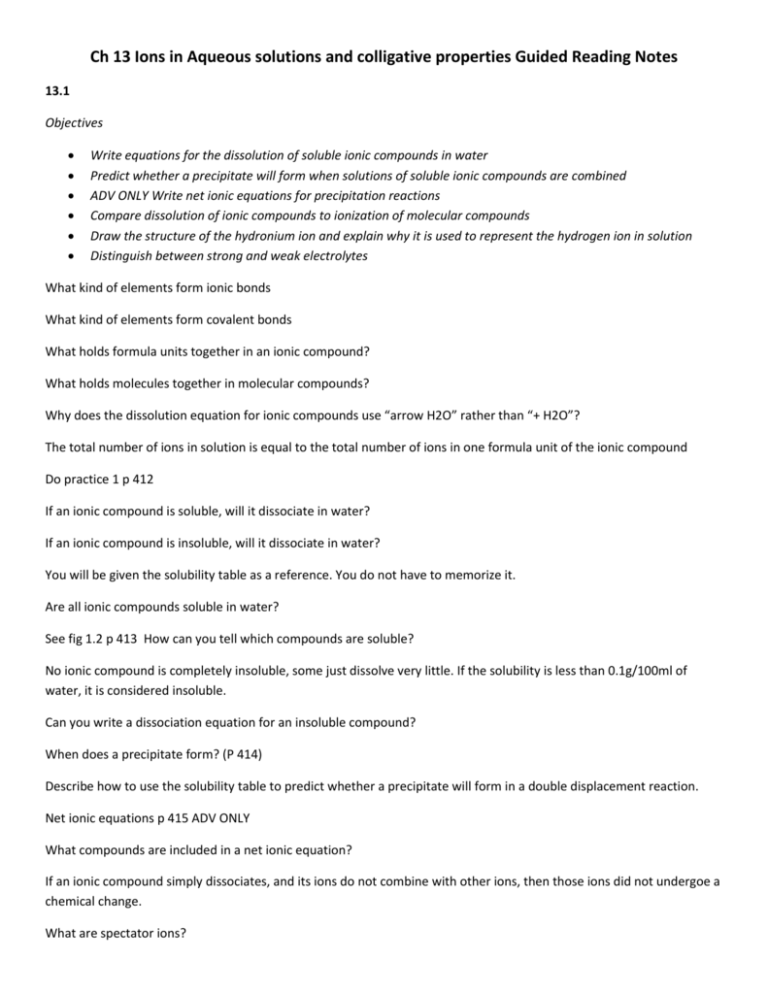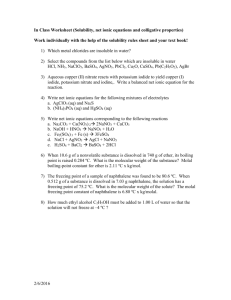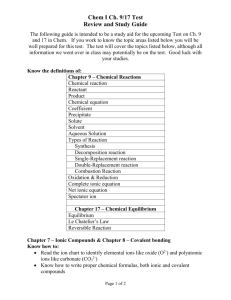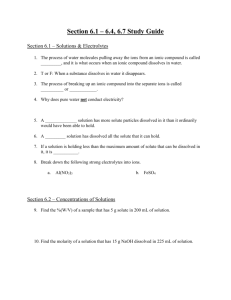File ch 13 chem guided reading notes
advertisement

Ch 13 Ions in Aqueous solutions and colligative properties Guided Reading Notes 13.1 Objectives Write equations for the dissolution of soluble ionic compounds in water Predict whether a precipitate will form when solutions of soluble ionic compounds are combined ADV ONLY Write net ionic equations for precipitation reactions Compare dissolution of ionic compounds to ionization of molecular compounds Draw the structure of the hydronium ion and explain why it is used to represent the hydrogen ion in solution Distinguish between strong and weak electrolytes What kind of elements form ionic bonds What kind of elements form covalent bonds What holds formula units together in an ionic compound? What holds molecules together in molecular compounds? Why does the dissolution equation for ionic compounds use “arrow H2O” rather than “+ H2O”? The total number of ions in solution is equal to the total number of ions in one formula unit of the ionic compound Do practice 1 p 412 If an ionic compound is soluble, will it dissociate in water? If an ionic compound is insoluble, will it dissociate in water? You will be given the solubility table as a reference. You do not have to memorize it. Are all ionic compounds soluble in water? See fig 1.2 p 413 How can you tell which compounds are soluble? No ionic compound is completely insoluble, some just dissolve very little. If the solubility is less than 0.1g/100ml of water, it is considered insoluble. Can you write a dissociation equation for an insoluble compound? When does a precipitate form? (P 414) Describe how to use the solubility table to predict whether a precipitate will form in a double displacement reaction. Net ionic equations p 415 ADV ONLY What compounds are included in a net ionic equation? If an ionic compound simply dissociates, and its ions do not combine with other ions, then those ions did not undergoe a chemical change. What are spectator ions? Are spectator ions included in the net ionic equation? True or false Changing a formula equation into an overall equation illustrates Dissociation True or false Changing an overall ionic equation to a net ionic equation illustrates Precipitation ADV ONLY practice probs 1 to 4 p 416. CP and ADV What is the difference between ionization and dissociation What kind of molecular compounds ionize? What determines the extent to which ionic compounds ionize? HCl ionizes in water to form ions. Compare the strength of the covalent bond holding the H and Cl together to the strength of attraction between the polar HCl and polar water. Polar molecules ionize in water solutions because each end of the polar molecule has a partial charge that is attracted to the oppositely charged end of a polar water molecule. This attraction pulls the polar molecule apart to form ions. HCl ionizes to form a hydrogen ion and a chloride ion. Given what you know about a hydrogen ion and its stability, do you think these hydrogen ions remain uncombined for long? Why it is more correct to represent what happens to HCl in water as HCl plus H2O rather than HCl arrow H2O? Which is more stable, the hydrogen ion or the hydronium ion? The formation of a hydronium ion releases energy . What is an electrolyte? What is the relationship between solubility and strong and weak electrolytes. Can something with a low solubility be a strong electrolyte? HF is a weak electrolyte, which means it only ionizes a little bit and not many ions are produced. HCl is a strong electrolyte. It ionizes almost completely and produces lots of ions. Use what you know about F and Cl to explain this. Compare the strength of the H-Cl bond to the strength of the H-F bond Notice that the ionization equations for weak electrolytes have a double arrow. That means that the reaction is reversible. You can tell if a substance is a strong or weak electrolyte by the arrow. 13.1 assignment equation questions p 419 , 1 to 5 p435 1,2,4to 10 ADV also do 4, 11 to 13. WS CP skip any net ionic 13.2 Objectives List 4 colligative properties and explain why they are colligative properties ADV Calculate freezing point depression and boiling point elevation and solution molality of non electrolyte solutions ADV Calculate the expected changes in freezing point and boiling point of an electrolyte solution. What is a colligative property? Use the graph on p 422 to answer these questions. What does the addition of a solute do to the freezing point of a solution? What does it do to the boiling point of a solution? Remember what equilibrium means. In talking about vapor pressure, it means that particle are leaving the liquid phase and going into the vapor or gas phase at the same rate that particles are leaving the gas phase and going into the liquid phase. The layer of vapor or gas above any liquid exerts pressure on the liquid. This is called “vapor pressure” Why is the vapor pressure above a solution less that the vapor pressure above a pure solvent (see fig 2.2 p 423). Why is the lowering of vapor pressure above a solution a colligative property? Notice on the graph on p 422. The temp range over which a solution remains a liquid is bigger that the temp range over which the solute alone remains a liquid. The freezing point is lower and the boiling point is higher. (You are comparing the blue line, which is the solution to the black line which is the solute alone). When talking about colligative properties we express the concentration of the solution in Molality (moles of solute per kilogram of solvent) rather than molarity (moles of solute per liter of solution). What is the molal freezing point constant for water? What would be the freezing point of a 5 molal solution of sugar water? See the table on p 424 . You are responsible for knowing water only. ADV only p 426 practice probs 1 to 4 What is the Molal boiling point constant for water? What would be the boiling point of a 5 molal solution of sugar water? ADV only p 427, 1 to 4 A semipermeable membrane is like a wire fence. Water molecules are able to pass freely through the openings in the fence. Large solute particles are not able to get through the openings, but are able to block the passage of many water molecules. The water molecules are blocked only on the side that has solute particles. Water molecules on the other side are allowed to pass through freely What is osmosis? What is osmotic pressure? Why is osmotic pressure a colligative property? Compare the freezing point depression of 0.1 molal solutions of sucrose, NaCl and CaCl2. Explain why they are different ADV only p 430 practice probs 1,2,3 Explain why salt is used on icy roads. Is the only substance that would work? Could sugar be used instead? Compare the amount of sugar you would have to use to get the same results as salt. 13.2 assignment ADV p 432 1 to 5 p 435 14, 15 to 34 ws pages Cp p 432, 13 p435 14,16,17,18 ws pages skip any problems about fp depression and bp elevation Ch 13 review assignment ADV p 437 35 to 45 P 439 1 to 11 ws pages CP p 437 37, 38, 41, p 439 1,2,4, ws pages skip any problems about fp depression and bp elevation






